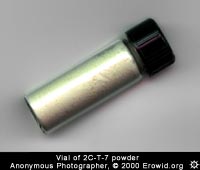2C-T-7
Basics
DESCRIPTION #
2C-T-7 is a psychedelic phenethylamine developed by Alexander Shulgin around 1980. The effects of 2C-T-7 share some general similarities with LSD & 2CB, with its length of action more like that of LSD. While most of the chemicals in its class are not known to cause acute physical dangers, 2C-T-7's safety profile for wide use is not well known nor researched. As with all new chemicals, it is difficult to be certain what the variety of reactions to the substance will be and the reports of use so far have a lot of conflicting and confusing elements, including duration, physical stimulation, dosage, etc.
A standard oral dose of 2C-T-7 is between 10 - 50 mg. It is generally found in powder form although it is also produced and sold in pill format, most recently at 7 mg per tablet. Insufflated doses are considerably lower. Users should be extremely careful with dosages as 2C-T-7 can cause unexpected delirium and dissociation at high doses.
Price #
Rare, but sometimes sold at parties for 5-20$ per dose, available from exotic chemical suppliers for 375-450$ per gram, about the same from underground suppliers. (August 2000)
2C-T-7 is was placed in Schedule I by emergency order of the DEA on September 20, 2002. This makes it illegal to buy, sell, or possess in the United States without a DEA license. Although Sweden controls 2C-T-7, we are not aware of any other countries that specifically list it as illegal to possess or sell.
2,5-dimethoxy-4-(n)-propylthiophenethylamine (2C-T-7) is a synthetic chemical in the phenethylamine class. It is related structurally to 2C-B and Mescaline.
Pharmacology #
Pharmacology Summary Needed.
Production #
Production Summary Needed.
2C-T-7's chemistry was first published in Alexander Shulgin's book PiHKAL in 1991. It was produced underground in college labs and by small commercial research labs until the late 1990's when it began being produced and sold commercially around the world.
Terminology / Slang #
The Substance:
2C-T-7; T7; Beautiful.
The Experience:
Tripping.
2C-T-7's effects are unique but classically psychedelic, with some general similarities to LSD & 2C-B. 2C-T-7's effects can include psychedelic visuals (patterning, light sensitivity, color enhancement, etc), mood lift, empathogenesis, anxiety or calmness, emotional volatility, increased sociability, associative / psychedelic ideation, etc. Some users have report unexpected and disconcerting dissociation at high doses. Relatively prominent visuals are common with 2C-T-7 and at higher doses the visuals can overwhelm the visual field creating a 'psychedelic soup'.
Onset #
Depending on how much and how recently one has eaten food, 2C-T-7 generally takes 1-2.5 hours to take effect. On a full stomach, onset can be considerably slower than normal.
Duration #
2C-T-7's primary effects can last as long as 10-12 hours, with after effects for another 4-6 hours.
Visual Effects #
Visuals Summary Needed.
PROBLEMS #
The most common problems reported by 2C-T-7 users appear to be nausea, vomiting, unpleasant dissociation,
and overwhelming visuals at high doses. As with most psychedelics, there is also the possibility of anxiety or panic attacks. In a few higher dose cases, severe dissociation has been reported where the user experienced loss of memory, mental confusion, and extreme inability to deal with real-world situations while fully physically functional. Some reports include the user becoming unusually enraged and violent. This can lead to potentially dangerous situations if an individual is left unsupervised. Heavy dissociation and vomiting can be a life-threatening combination. At least 3 deaths have been reported (April 2001).
Contraindications #
- Do not take 2C-T-7 if you are currently taking an MAOI. MAOIs are most commonly found in the prescription anti-depressants Nardil (phenelzine), Parnate (tranylcypromine), Marplan (isocarboxazid), Eldepryl (l-deprenyl), and Aurorix or Manerix (moclobemide). Ayahuasca also contains MAOIs (harmine and harmaline). 2C-T-7 and MAOIs are a potentially dangerous combination. Check with your doctor if you are not sure whether your prescription medication is an MAOI.
- Do not operate heavy machinery. Do Not Drive.
- If you have a seizure or convulsive disorder or heart problems, you may be at higher risk for health problems when taking 2C-T-7. Diabetics should monitor their blood sugar closely as there have been some reports of problems.
- Individuals currently in the midst of emotional or psychological upheaval in their everyday lives should be careful about choosing to use psychedelics such as 2C-T-7 as they can trigger even more difficulty.
- Individuals with a family history of schizophrenia or early onset mental illness should be extremely careful because psychedelics have been known to trigger latent psychological and mental problems.
Addiction Potential #
2C-T-7 is neither physically addicting nor likely to cause psychological dependance. Withdrawal effects following discontinuation have not been reported. As with most substances, some people will use it more frequently than they are comfortable with. There is a short period of tolerance after 2C-T-7 use. Using 2C-T-7 two days in a row is likely to lead to a diminished experience the second day, though spaced 5-7 or more days apart, this effect is nearly non-existent.
Long Term Health Problems #
Long Term Health Problems Summary Needed.
Risk of Death #
There have been 3 deaths which have been tied directly to 2C-T-7. The exact mechanism of death is not yet known, but it is beginning to appear that some direct pharmacological effect may be responsible (rather than an indirect effect such as aspirating vomit). There have been no formal evaluations of the Toxicity of 2C-T-7 that we're aware of.
CAUTION & DISCLAIMER #
Erowid Basics pages are summaries of data gathered from site visitors, government documents, books, websites, and other resources. We do our best to keep this information correct and up-to-date, but the field is complex and constantly changing. Information should always be verified through multiple sources.



